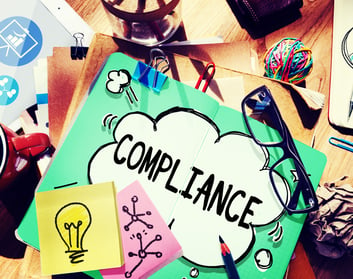In today’s digital age, data security and privacy are paramount. For businesses that handle customer data, demonstrating a commitment to safeguarding that information is essential for building trust and maintaining a competitive edge, as well as meeting cybersecurity compliance. One of the most recognized standards for data security is the Service Organization Controls (SOC) 2 report.
Let’s delve into what SOC 2 is, why it matters and how to achieve compliance.
Read: How to Be GDPR Compliant and Protect Sensitive Data
What Is SOC 2?
SOC 2 is a voluntary compliance framework developed by the American Institute of Certified Public Accountants (AICPA) in 2010. It ensures that service providers implement security controls to manage sensitive data and protect their clients’ interests and privacy from unauthorized access, cyber attacks and more, demonstrating a commitment to data security and privacy. These controls are unique to each company’s specific business practices, and they are based on the five Trust Service Criteria (TSC):
- Security: The system and data are protected against unauthorized access, disclosure, use, modification or destruction. Security is the only criterion companies must follow in their SOC 2 report.
- Availability: The system and data are available for operation and use as committed or agreed by the customer or business partner, typically in the service level agreement (SLA).
- Processing integrity: The system processing is complete, valid, accurate, timely and authorized, and it protects the confidentiality, privacy and security of information processing.
- Confidentiality: Information designated as confidential is protected as committed or agreed from unauthorized access or disclosure.
- Privacy: Personal information is collected, used, retained, disclosed and disposed of in conformity with the commitments in the entity’s privacy notice.
Achieving and maintaining SOC 2 compliance is crucial for any service organization that collects, stores, processes or transmits sensitive customer data, including software as a service (SaaS).
There are two types of SOC 2 reports companies should know:
- Type 1: Describes your systems and whether the system’s design complies with the relevant TSC at a single point in time
- Type 2: Details the operational effectiveness of these systems and security controls over a period of time
Steps to Achieve SOC 2 Compliance
Achieving SOC 2 compliance requires a systematic approach:
- Understand the Trust Service Criteria: Familiarize yourself with the five Trust Service Criteria and understand how they apply to your organization. This will help you identify the specific controls and processes that must be implemented or improved.
- Conduct a readiness assessment: Before undergoing a formal SOC 2 audit, conduct an internal readiness assessment. This involves reviewing your current processes, identifying risks and gaps and implementing necessary changes. Engaging a third-party consultant can be beneficial in this step to ensure an unbiased assessment.
- Implement necessary controls: Based on the findings of your readiness assessment, implement necessary controls, data processing integrity and policies to protect confidential data. This can include security measures like an incident response plan (IRP), a disaster recovery plan (DRP), limited access controls, firewalls, encryption and multi-factor authentication.
- Document policies and procedures: Ensure all your controls, policies and procedures are well-documented. This documentation should include security policies, data handling procedures, IRP and employee training programs.
- Train your staff: Speaking of employee training, provide comprehensive training on SOC 2 requirements and the specific controls your company has implemented. Regular training sessions and updates are crucial to maintain compliance.
- Engage an independent auditor: Hire an independent certified public accountant (CPA) experienced in SOC 2 audits to conduct a formal external assessment. The auditor will run tests where they review your security controls, test their effectiveness and provide a report on how the security controls meet and comply with one or more of the TSC.
- Address the audit findings: If the auditor identifies any deficiencies or vulnerabilities, address them promptly. Implement corrective actions and resolve the issues before the final report is issued.
- Obtain and share the SOC 2 report: Once you have successfully completed the audit, obtain the SOC 2 report, which details the CPA’s opinion on how your company complies with the TSC. This can be shared with clients and stakeholders to demonstrate your commitment to data security and privacy.
Read: Is Your Business Cybersecurity Compliant?
Penalties for Non-Compliance
Failing to comply with SOC 2 can have severe repercussions for your organization:
- Loss of business: Many clients, especially those in highly regulated industries, require SOC 2 compliance as a condition for doing business. Non-compliance can result in lost contracts and reduced revenue opportunities. Clients might choose to work with competitors who have demonstrated a commitment to data security.
- Reputational damage: A breach or failure to protect customer data can severely damage your reputation. Trust is paramount in today’s digital landscape, and a damaged reputation can be difficult to rebuild.
- Legal liabilities: Non-compliance can lead to legal actions from clients or customers who suffer damages due to inadequate data protection measures. This can result in costly lawsuits and settlements, as well as legal fees.
- Operational disruptions: Without the proper controls in place, your organization may face significant operational disruptions in the event of a data breach or other security incident. These disruptions can be costly and time-consuming to resolve.
- Financial penalties: Although SOC 2 does not impose fines, non-compliance with SOC 2 can lead to non-compliance with other regulations that impose financial penalties, like GDPR.
Maintaining SOC 2 Compliance with Thriveon
SOC 2 compliance is an ongoing process. Continuous monitoring, testing and improvement are essential to maintaining compliance and protecting your organization. This can take a lot of time and resources, so partnering with a managed service provider like Thriveon is a beneficial move.
Our experienced staff can help you meet SOC 2 compliance, and we can help you stay secure and compliant. Schedule a meeting today to see how we can help your business.

